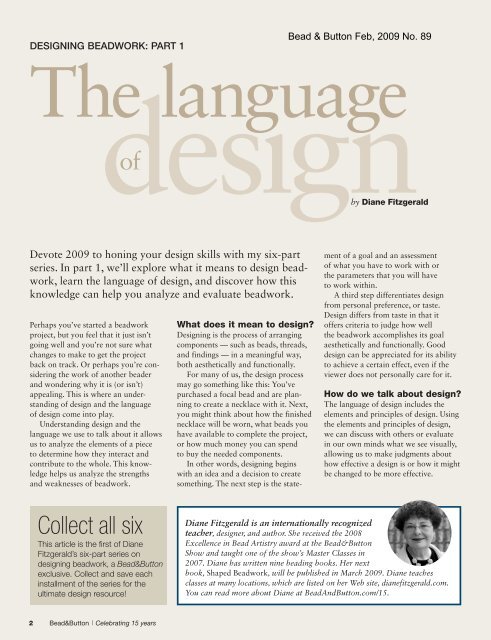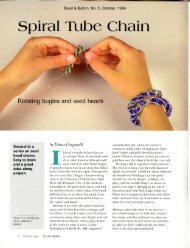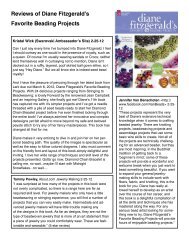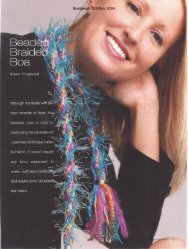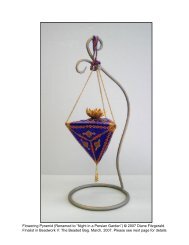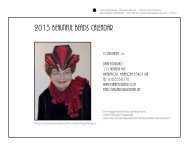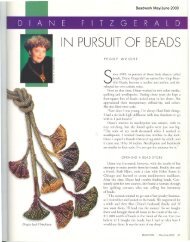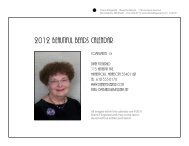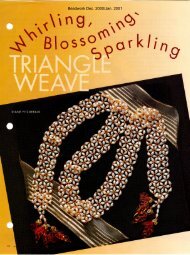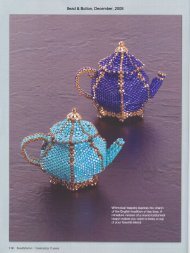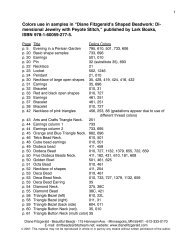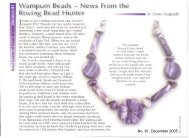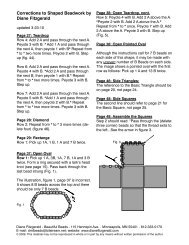Design - Diane Fitzgerald
Design - Diane Fitzgerald
Design - Diane Fitzgerald
- No tags were found...
Create successful ePaper yourself
Turn your PDF publications into a flip-book with our unique Google optimized e-Paper software.
The elements of designThe elements of design are visual componentsthat can be manipulated and modifiedin creating an object or composition.1Points and lines: Points and linesare linear marks made with a pen,brush, or other device or the edgecreated when two shapes meet. In beading,strung necklaces may be thought ofas a series of points and lines.Closely related to line is the conceptof direction, which may be horizontal,vertical, or diagonal. Horizontal linessuggest calmness, stability, and tranquility.Vertical lines give a feeling of balance,formality, and alertness. Diagonal linessuggest movement or action.2Shape and space: Shape is definedas areas of three-dimensional geometricor organic form. Shape mayalso be referred to as volume, mass, orarea. One way that shape is importantin beading is the way a necklace’s shapeinteracts with one’s face and upper body.Space is the area surrounding forms,shapes, lines, and points.3Light and transparency: Lightis radiant energy from the sunor other source that allows us tosee and creates highlights and shadows.Transparency is the ability of light to passthrough an object so that images can beperceived as being behind it. In beading,metal, glass, stone, and other materialsmay be reflective or transparent.4Motion: Motion is actual movement,but it may also be expressedthrough repetition, gradation, orother visual effects. In beading, motionis exhibited in dangles, which attract theeye, and in the movement of our eye asit follows a path through a piece.5Color and value: Color is a generalterm used to describe the perceptionof light as our eye sees it. Color orhue refers to characteristics that we callred, blue, orange, brown, black, white,and other names. Color has value, consideredin terms of lightness or darkness.Value is sometimes referred to as tone.6Pattern and texture: Patterns arevisual elements of design, whichare repeated, while texture is thesurface quality communicated by touch,although it may be perceived visually aswell. In beadwork, tiny seed beads createa pebbly texture while glass, stone, ormetal beads create a smooth surface.The principles of designBead & Button Feb, 2009 No. 89Try it yourselfIdentify which of the four principlesof design is at work in each ofthese pieces. For answers, visitBeadAndButton.com/resources.1. Crystal geometry necklace2. Braided garland necklaceThe principles of design serve as guidelinesto help us see relationships amongthe elements of a design. They are nothard-and-fast rules. Think of them assuggestions to use in evaluating a design.1Proportion: Proportion refers to therelative size and scale of objects ina design. It may carry implicationsabout the message or goal of the piece.2Balance: Balance is the concept ofvisual weight and how it is distributed.It relates to our physical senseof balance. Balance may be symmetricalor asymmetrical.3Rhythm, repetition, and emphasis:Rhythm is the path our eye followsas it moves through repeatedelements to reach the final destination,which is the emphasis. Emphasis is thefocal point, the most important elementin the design.4Variety and unity: Variety is ameans of adding interest to a piece,while unity is the principle thatconnects the variety. Both variety andunity should be present in good designs.All of the above elements and principlesmay be applied to our beaded designs.Study them in preparation for part 2of this series, coming in the April issue,in which we will discuss points, lines,and shapes.For a great online tutorial of designby one of my college professors, CharJirousek, go to http://char.txa.cornell.edu/. The time you spend at this sitewill be well worth it.3. Celtic trefoil necklace4. Wild flowers necklacewww.BeadAndButton.com | February 2009
DESIGNING BEADWORK: PART 2Points,Bead & Button April, 2009 No. 90wwwFor more information about designingbeadwork, go to the Community tab atBeadAndButton.com. To learn moreabout <strong>Diane</strong>, visit BeadAndButton.com/15.lines shapesby <strong>Diane</strong> <strong>Fitzgerald</strong>&In part 1 of this series, we covered the language of design —including the elements and principles of design — as it appliesto bead stringing and stitching. In part 2, we’ll discuss threeof the elements in greater depth.In the first installment of this series,we briefly talked about points, lines,and shapes. A point is a single entity,a line is an entity that extends linearly,and a shape is a two- or three-dimensionalform.These elements of design are importantvisual components that appear inevery bead composition. A single beadmay be considered a point, and whenseveral are strung, they create lines.Lines may define the boundaries ofan object or divide a space, and thusthey create a shape. Also, each bead hasa distinctive shape, and two or morebeads strung or stitched together createa new shape.Part 2 of 6This is the second installment of<strong>Diane</strong>’s six-part series. To readpart 1 from the February 2009issue, go to BeadAndButton.comand click on the Magazines tab,then Back Issues. Look for part 3in the June 2009 issue.The power of points and linesPoints and lines can suggest many newideas for our bead projects. Lines —or beads that are strung, embroidered,or stitched together — communicateideas in myriad ways.For example, consider directionallines. Horizontal lines are less formaland suggest calm, repose, and stability.Vertical lines suggest majesty, stateliness,and height.Diagonal lines are active and dynamic,suggesting movement. Being neithervertical nor horizontal, the lines createtension because we are uncertain whichway the lines will tilt or move.Curvilinear lines, spiral lines, andmeandering lines may suggest playfulness,the naturalness of vines or tendrils,or a path through a forest. Curvilinearlines are also related to calligraphy andcan impart ideas through culturallyunderstood written language.In contrast, zigzag lines convey excitementlike a bolt of lightning. All of theselines create rhythm if repeated regularly.Lines may be broken or comprisedof a series of points (or beads), butour minds will complete the line eventhough parts are missing. For example,a dotted or dashed line is usuallythought of as a continuous line eventhough it has gaps.Lines can also direct our attention.Intersecting lines bring our eye to thepoint where they cross and may leadus to the focal point of a piece.What’s in a shape?Shapes are similar to lines in the waythey convey information. We associatecertain shapes with familiar objects:A drop shape may suggest the movementof liquid, a pointed oval may suggest aneye, and a triangle may suggest a tree.Also consider how the overall lineor shape of a necklace relates to thewearer’s face, neck, and upper torso.A short necklace worn near the collarbonemay be more flattering to someonewith a small, oval face because it tricksthe eye into thinking that the face islarger and wider.A longer necklace, such as onethat lays just above the bust line, maybe more flattering to someone witha round or squarish face because thenecklace will lengthen the face ina pleasing way.Similarly, a necklace that comes toa sharp V, such as one with a pendant,will tend to soften the lines of a torsowith broad shoulders because it willguide our eye away from the shoulderstoward the point of the V. Necklaces thatreach almost to the waist may have aslimming effect or make one appear taller.Bead&Button | Celebrating 15 years
Photos by <strong>Diane</strong> <strong>Fitzgerald</strong>Photos by Petronella Ytsma35From the National Museum of the American Indian12461. Repeating lines form this simplebut elegant collar by Sonya Monzel.A series of polychrome crochetedropes are seen as a unified overallshape that is flattering to the wearerwithout being overpowering.2. Simple shapes convey meaning.My inspiration for this piece was anancient Egyptian necklace featuringthree Golden Fly of Valour pendantsfound in the grave of Queen Ahhotep.My gold stitched Vs evoke wings,and the black oval beads recall thebody of a fly.3. In a necklace by Shawn Judge,we see examples of directionallines that may suggest the pricklyspines of a sea urchin. Note howthe artist uses a curving line ina lighter color to suggest anothertype of movement, but one thatdoes not detract from the radiatingmovement of the black and whitespines.4. In another piece by ShawnJudge, elongated beads createsharp, angular lines punctuated bysmall beads at the vertices. Theelongated beads also create newshapes, such as the triangle, whilethe black and white disk beads arestrung to form a curving line. Circularlines or shapes are also presentin the three black rings and theblack donut. The combination ofangles and circles creates a strikingcontrast of shape.5. In this Blackfoot dress, ca. 1860,high-contrast black and white linesof beadwork flow across the yokeand down the sleeves to create abold horizontal design and a curvilinearshape. Vertical lines extendacross the yoke and down thesleeves but are secondary, connectingother elements withoutcompeting with the black and whitestripes. The beaded fringe belowthe stripes continues these verticallines and adds movement.6. The elk teeth on this Crow dress,ca. 1900, function as points andform repeating concentric lines ina semi-circular pattern accentedwith lines of seed beads anda yoke of red wool in a V shape.Narrow strips of leather add verticallines and create movement.Bead & Button April, 2009 No. 90PracticeYou might need to train yourself to seerelationships between points, lines, andshapes. Here are three exercises to get youthinking about these elements and howthey interact in different visual settings.Exercise 1: In a small notebook thatyou carry with you, begin to jot downwords that express different kinds oflines as you think of them or notice them.Draw a picture of the line next to theword. Later, add words to express theidea that the line communicates.Exercise 2: Assemble an assortment ofbeads of different shapes but in only twocolors, such as black and gold. Look forround beads in several sizes, bicones,cubes, drops, barrels, ovals, dog bones,diamond shapes, disks, nuggets, riceshapes, tubes, rondelles, bugles, andother shapes.On a 3-in. (7.6 cm) head pin or pieceof wire, string three or more beads, andconsider the new shape that is madewhen they are combined. Photograph,scan, or photocopy each combinationfor future reference. Repeat the process.Exercise 3: Wearing a plain, round-neckshirt, put on a necklace and look at it ina mirror. You can also ask a friend to wearit or put it on a body form. Describe theline that is formed by the overall necklace.Is the line created at its boundaryround, oval, pointed or another shape?Compare this shape to the shape of thewearer’s face. Now try on another necklaceand see which is most flattering. w<strong>Diane</strong><strong>Fitzgerald</strong> is aninternationallyrecognized teacher,designer, and author.She received the 2008 Excellencein Bead Artistry Award at theBead&Button Show and taughtone of the show’s Master Classesin 2007. <strong>Diane</strong> has written 10beading books. Her latest book,Shaped Beadwork, was publishedin March 2009. <strong>Diane</strong> teaches classesat many locations, which are listed onher Web site, dianefitzgerald.com.www.BeadAndButton.com | April 2009
Bead & Button June, 2009 No. 91DESIGNING BEADWORK: PART 3Light& motionby <strong>Diane</strong> <strong>Fitzgerald</strong>In part 3 of this series, I will discuss three elements of designthat are very important yet easy to overlook as we assembleour jewelry.Shedding light on lightWe know that light can affect ourmoods. In sunlight, we are likely tofeel happy and energetic, while acloudy day may bring on lethargy.Light can affect our beads as well,but in different ways.Light reflects off of objects and intoour eyes, allowing us to see. The sparkleor flash of faceted-glass beads is just oneexample of the mystery and magic oflight that makes these beads so appealing.The color of light will change theappearance of our beadwork. Fullsunlight has a wide spectrum of colorand will give a true color reflection.Some fluorescent light may shift colorstoward blue tones. Moonlight tendsto wash out color and makes everythingappear in shades of white or gray,suggesting an eerie quality.In general, it is a good idea to selectbeads in daylight, but interesting effectsmay result from selecting beads in thelight in which they will be viewed. Forexample, if beads will be worn duringan intimate candlelit dinner, use lowlight to select the colors.Light also creates highlights andshadows on surfaces with depressionsand contours such as we find in beadwork.If we are creating a flat surfaceof beadwork, we may want to createthe appearance of highlights or shadowswith the bead colors we choose, creatingthe illusion of dimensionality.<strong>Diane</strong> <strong>Fitzgerald</strong> is an internationally recognized teacher,designer, and author. She received the 2008 Excellence inBead Artistry Award at the Bead&Button Show and taughtone of the show’s Master Classes in 2007. <strong>Diane</strong> has written10 beading books. Her latest book, Shaped Beadwork, waspublished in March 2009. <strong>Diane</strong> teaches classes at many locations, whichare listed on her Web site, dianefitzgerald.com. You can read more about<strong>Diane</strong> at BeadAndButton.com/15.Bead surfaces reflect light differently,depending on their molecular structure.Pearls have a subtle sheen, while someshells reflect a rainbow of colors. Thegemstone tigereye exhibits silky bandsof luminescence called chatoyancy.Beads with an iridescent finishappear in a range of colors from blueand green to gold and magenta, similarto an oil slick on water. CRYSTAL-LIZED - Swarovski beads come ina wide range of light-reflecting finisheswith names to suggest their effects: starlight,purple haze, Aurora Borealis (AB),satin, and golden shadow.Transparent intentionsTransparency is the ability of light topass through an object so that imagesare perceived as being behind it or belowits surface. This element of design is mostapparent with glass and plastic beads.For example, many glass-bead makerstoday create intriguing compositionsthat are encased in clear glass, givingthe effect of seeing the inside of thebead through a window or under water.We can also see the effects of transparencyin our use of stringing material.Thread or cord color that shows throughbeads will change the perceived colorof the glass (even opaque glass) andprovides an additional design elementto consider.Bead&Button | Celebrating 15 years
PatternDESIGNING BEADWORK: PART 4textureby <strong>Diane</strong> <strong>Fitzgerald</strong>The pattern and texture of our beads and beadwork saya lot about the jewelry we make. In part 4 of this series,I’ll teach you how to harness the power of these twoelements of design.All surfaces, including the surfacesof beads, are covered with patterns ortextures. Patterns are organized surfacecoverings that generally repeat regularly,while textures are more random, irregular,and less organized.One way to think about patterns isto categorize them. Some patterns formgrids, such as a checkerboard or otherrepeats of a geometric shape, like thehexagonal cells of a honeycomb. Eachof the cells within a grid may containother patterns or motifs (for instance,a repeated line, shape, or color) tocreate a finer structure.Other patterns may be thoughtof as branching, as with plant forms;spirals, like the ones found in shellsor flowers; and flowing patterns thatconvey movement, such as meanderingor undulating lines.Of all the design elements, textureis perhaps associated the most withour sense of touch. Because of theappeal of this tactile element, we oftensee people touch beads with their forefinger,connecting with and taking ininformation from the texture.Pattern and texture are importantdesign elements to consider when workingwith beads. Let’s look at strungjewelry first.Stringing patterns,considering texturesThe simplest form of pattern in stringingis alternating beads: a large beadthen a small bead, or a shiny bead thena matte bead. To bring interest to ourpieces, we often combine several differentshapes of beads and repeat themto make complex patterns. Even whenwe limit ourselves to just two colorsand a few shapes, we can createa wide variety of patterns.When combining different patterns,trust your judgment about what workswell. Use your digital camera or a scanneror make a sketch of each arrangementof beads as you create it so thatyou can go back and compare theresults. Of course, color will influencethe pattern, and we’ll discuss that ina future article.In stringing, we should also considerthe variety of materials that beads aremade from: crystal, glass, wood, shell,polymer clay, metal, bone, and manyother materials, each with the possibilityof many types of surface textures. Asa result, beads may be shiny, matte, orpatterned in any of the ways mentionedabove. The surface pattern or texturemay even be directional, such as a woodgrain or swirling pattern.Part 4 of 6So far in this series, <strong>Diane</strong> hascovered five of the six elementsof design. Next up in the Octoberissue — color.wwwIn part 1 of this series, publishedin our February 2009 issue, <strong>Diane</strong>gave an overview of the elementsand principles of design. You canread it online at BeadAndButton.com/jewelrydesign. To read parts 2 and 3,order our April and June issues.Go to BeadAndButton.com andclick Magazines, then Back Issues.“In working with seed beads, a critical consideration is contrast of texture.”Bead&Button | Celebrating 15 years
Stitching contrastingpatterns and texturesNow, let’s turn our attention to stitched beadwork, made withseed beads, cylinders, triangles, cubes, and other small beads.When seed beads are combined in peyote stitch, brickstitch, or right-angle weave, a specific pattern or textureresults depending on how the beads are oriented. As lightplays across these tiny beads, we see the highlights andshadows that are created by their shapes.These patterns and textures may be overpowering, and weneed to provide relief for the eye with a contrasting smoothtexture. In a recent review of entries in a bead contest, lack ofcontrasting textures was the biggest problem. Beautiful glassbeads were often lost in the texture of the beadwork, andmany pieces ended up looking jumbled. In working with seedbeads, a critical consideration is contrast of texture.We also need to consider the direction or flow of pattern andtexture that results when we stitch. In peyote and brick stitches,the beads lie in a single direction, but with right-angle weave,beads lie perpendicular to each other. In herringbone stitch,alternating beads are slightly angled. With bead embroidery, thetextural flow of beads can be in any direction that emphasizesthe design. Familiarity with each stitch is important so we canselect a stitch that will achieve the desired effect.For example, when stitching a triangle with peyote stitch,the direction of the stitch emphasizes the overall shape. Ifwe stitched a triangle with right-angle weave, the textureof the weave (square) would detract from the overall shapeof the triangle.Another example might be trying to create the texture ofsnakeskin for a tube. In that case, herringbone might suggesta snake’s scales and help convey the message or intent of thepiece more clearly.And speaking of messages in the beads, the surface finishesof seed beads say something about a piece. When you selectbeads for a project, you might choose from silver-lined,metallic, AB, opalescent, opaque, and matte beads. Generally,the first four finishes are considered more “elegant,” whilethe last two are more casual or ethnic.Thus, whether we are stringing or stitching, we wantto select beads and stitches with patterns and textures thatenhance the intent of the piece rather than detract from it. w<strong>Diane</strong> <strong>Fitzgerald</strong> is an internationallyrecognized teacher, designer, and author.She received the 2008 Excellence inBead Artistry Award at the Bead&ButtonShow and taught one of its Master Classesin 2007. <strong>Diane</strong> has written 10 beadingbooks. Her latest book, Shaped Beadwork, came out inMarch 2009. <strong>Diane</strong> teaches classes at many locations, whichare listed on her Web site, dianefitzgerald.com. You can readmore about <strong>Diane</strong> at BeadAndButton.com/15.Although the cylinder beads in this strip are very close incolor, their finish makes each unique: DB607 (silver lined),427 (galvanized), 1782 (white lined), 217 (opaque), 786(matte), 166 (opaque), and 627 (silver lined).James Jones is a master at creatingboth pattern and texture on thesurface of glass beads.The direction orflow of texture isa consideration inmy bead-embroideredOrange Pimpernel Pin.Here the backstitchedbeads emphasizethe outline of theflower petals.A necklace in the exhibit Afghanistan:Hidden Treasures from the NationalMuseum, Kabul inspired the beadedbeads in my Tillya Tepe Necklace.Note both the pattern of thestringing and the textureand pattern created bythe beadwork.
LASTINSTALLMENT!wwwBeadAndButton.com registered users can view the previous installments of <strong>Diane</strong>’s six-part series online. Go toBeadAndButton.com, click the Community tab, and select Jewelry <strong>Design</strong>. As always, registration is free and easy!the design imparts, such as a message oforder, beauty, or excitement. As viewersof a beaded object, we try to make senseof the message. If we quickly see andunderstand a grouping of beads — forinstance, if they have a similar color,shape, or texture or communicate anobvious theme — we are quickly satisfied.But if we have to study the groupingfor a bit to make sense of it, webecome more engaged and thus moresatisfied when we “figure it out.”?Ask yourself: Are elements ina piece grouped to add interestor convey a message? What newshapes or patterns are created bythe grouping?Carried along by rhythmWe achieve rhythm by repeating orgrouping shapes, colors, textures, andpatterns at spatial intervals. Rhythmhelps our eyes move around a piece,providing stepping stones from onepart to another. It also helps bring oureyes to the focal point and to moveaway from it again.Radial rhythm occurs in elementsthat emerge from a central point, suchas a flower or star, while gradation isa form of rhythm that helps the viewersee movement from foreground to background.Gradation may involve arrangingcolors from dull to intense, fromlight to dark, or from hue to hue.?Ask yourself: How do my eyestravel through the piece fromelement to element? Is the pieceengaging and pleasing in parts andas a whole?Emphasis = ImportanceEmphasis is the quality of dominanceor being most obvious. We want toaccent a particular element in our jewelryto give the viewer a sense of what thepiece is about and what is important init. Emphasis can be achieved throughplacement in both formal and informalbalance, and through contrast of color,texture, or size of the elements.?Ask yourself: What is the mostimportant part of this piece?Does its placement reinforceits dominance?Size mattersProportion involves comparisons ofthe size of elements to each other andto the piece as a whole. In jewelry, wemight compare the size of the beadsand elements to the overall length ofthe necklace, and the size of the necklaceto the wearer’s body.For example, a short, single-strandnecklace of tiny seed beads might seemout of proportion if worn by a largerperson, or a long necklace of big,chunky beads might seem to overpowera petite person.Likewise, a few seed beads may betoo weak to support a large bead, whichwill confuse the message for the viewer.My sister recently found some smallsnowflake beads. Her first impulse wasto use larger round beads to set themoff, but she quickly realized that thelarger beads overwhelmed her snowflakes.This is also an example of howproportion affects emphasis.?Ask yourself: How do the proportionsof the elements relate to eachother and to the whole?Achieving unified varietyUnity is the compatibility of elementsin a design or their relationship to eachother and to the whole. We say a pieceis unified if the parts work together ina harmonious way. This means that theparts have something in common,whether it is color, line, form, or texture.But unity alone can become monotonous,so this principle should not becarried to the extreme. Within unity,variety can add excitement and keep theviewer visually alert.For example, elements in a necklacemay be related by their bold geometricshapes, but their primary colors addvariety. Another example is a charmbracelet. The charms may be varied inwhat they represent but related in theiroverall theme, such as mementos oftravel, grandchildren, or life events.?Ask yourself: How is the pieceunified? Is there variety withinthe unity?Go forth and bead!As you can see by the examples to theright, combining multiple principles ofdesign in a single piece adds interest toyour work, pleases the eye, and satisfiesthe viewer. With these principles inmind, you’ll feel more confident duringthe creative process. You’ll also be ableto get past design dilemmas by evaluatinghow the principles are (or are not)working in your piece.So get beading! With your knowledgeof the elements and principles of design,plus a little patience and practice, you’llhave all the tools you need to designbeautiful beadwork. wRhythm and emphasis: The rhythmof the white-capped waves in Land ofthe rising sun necklace aids the eye inmoving through the piece. There is nodoubt about the emphasis: The orangesun bead is the focal point. The sunbead is by Jeff Barber.<strong>Diane</strong> <strong>Fitzgerald</strong> is an internationally recognized teacher,designer, and author. She received the 2008 Excellence inBead Artistry Award at the Bead&Button Show and taughtone of the show’s Master Classes in 2007. <strong>Diane</strong> has written10 beading books. Her latest book, Shaped Beadwork, waspublished in March 2009. <strong>Diane</strong> teaches classes at many locations, which arelisted on her Web site, dianefitzgerald.com. You can read more about <strong>Diane</strong> atBeadAndButton.com/15.www.BeadAndButton.com | December 2009 43


